
 |
|
|
|
Late in November of 1980 United Artists took out a glossy multi-page ad in Daily Variety extolling Heaven's Gate as the artistic triumph of the century. A few days later we read that the movie had been judged a complete washout, in some of the worst reviews ever read. It was pulled from exhibition in less than a week. More damning was the industry outrage that a director had been permitted to waste $40 million of TransAmerica's investor dollars. In what amounted to a media lynching, "the biz" came down hard on Heaven's Gate. The newly elected Ronald Reagan was already in the process of forcing unions to bow to the needs of corporate America. The moneymen that controlled the studios blamed all their woes on profligate directors. Michael Cimino had been handed a once-in-the-history-of-movies opportunity with Heaven's Gate. Just a couple of years before, the heavy-hitting top brass of United Artists defected to form Orion Pictures. The remaining UA executives green-lit Cimino's film and allowed him to run wild. This part of the story has been told in Steven Bach's book Final Cut as well as 1,001 sarcastic editorials decrying the expenditure of so much money on such a universally panned, totally uncommerical project. 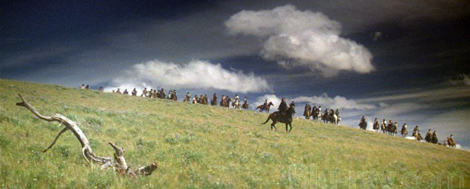
The movie has been in limbo ever since. The original 219-minute cut disappeared save for a few showings on the Los Angeles "Z" cable channel. United Artists was sold to MGM, which put out a truly terrible-looking non-anamorphic DVD in 2000. A couple of years ago Criterion licensed a group of MGM titles and set out to bring Heaven's Gate to Blu-ray in a new restoration. Is Heaven's Gate worth seeing? Yes, definitely. Is it an unrecognized masterpiece? No way, not by a long shot. Cimino's film is enjoyable in the way that many epics are enjoyable -- its size can be pleasing in itself. It has attractive stars, attractive scenes, and hours (and hours) of beautiful scenery. But it's also a heavy film, weighed down by its theme and a snail's-pace approach to the oft-told story of settlers forced to fight wealthy cattlemen for the right to settle the open plains. Starting with some research on barbed wire, Cimino fashioned an alternate, highly politicized version of this tale. The cattlemen are evil capitalists that place profits over human lives. The settlers homesteading the inhospitable open range are now impoverished Eastern European immigrants. To drive them out the cattlemen brand them as foreign degenerates, thieves and anarchists. The law, the army and the government look the other way as Wyoming is 'cleansed' of undesirables. Cimino's main character is a mostly powerless witness to this social and political catastrophe. Twenty years after graduating from Harvard, the wealthy James Averill (Kris Kristofferson) is the Federal Marshall of Johnson County. Cully the stationmaster (Richard Masur) tells Averill that the Stockgrower's Association is importing gunslingers to 'legally' kill 125 immigrants placed on a Death List. Association President Frank Canton (Sam Waterston) can't wait to secure the entire state as a privately owned ranch. One name on the Death List is Averill's girl friend, brothel madam Ella (Isabelle Huppert). She reportedly takes stolen cattle in lieu of cash for services rendered. Ella's other boyfriend is one of Canton's regulators, Nate Champion (Christopher Walken), who has already earned a bankroll by shooting immigrants that he catches with stolen cattle. A wave of murder is coming but Averill can't convince Ella to leave. Bartender John Bridges (Jeff Bridges) sympathizes with the immigrant mob but does nothing to help them. The local army commander (Terry O'Quinn) has been ordered to stand down. Upset that Ella has accepted Nate's proposal of marriage, Averill drinks himself into a stupor just as Canton and his mercenaries arrive by train to begin their war on the immigrant class. Spurred on by a socialist orator in their ranks (Brad Dourif), the disorganized homesteaders rush out to confront Canton's private army. It's class warfare, a rabble vs. the capitalists. Heaven's Gate has narrative similarities with Sergio Leone's later Italian westerns, operatic exercises in mythomania. As he does in parts of The Deer Hunter, Michael Cimino aspires to capture the free-flowing pageantry of Luchino Visconti or Bernardo Bertolucci, on a much larger scale and with a story that could be told in eighty minutes. After the situation in Wyoming is laid out, we soak up hours of detail and atmospheric set pieces while very little happens that is essential. Averill, Ella and Nate's romantic triangle amounts to a hangdog version of Jules and Jim minus forward momentum. Both rivals ask Ella to leave town at least three times, with a separate slow scene devoted to each attempt. Even after it has been made obvious that a militia is on its way to kill practically everybody, the main characters do not act. Scenes seem to be repeated, with little variation: noisy peasant gatherings, buggy rides, Canton marshalling his hired guns. 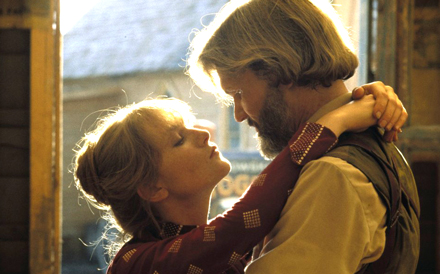
James Averill's most heroic quality is his terrific fashion sense. He spends much of the movie avoiding the central story problem -- either passing the time with Ella or drinking himself senseless. When he does engage, he's only good for a random punch in the face or two. The dictatorial Frank Canton calls Averill a traitor to his class. One would think that Averill could use his Ivy League connections to spread the word back East about the outrageous events in Johnson County. A scandal in the Yellow Press might nip Frank Canton's plans in the bud. Why is there no newspaper presence in Casper? Imagine the journalistic stink that the liberal firebrand Mark Twain could stir up over the plans of the Stockgrowers' Association. Cimino's style does not place much importance on narrative pace. He concentrates on real-time behaviors, the quality of the air, the feeling of 'being there'. We're given plenty of time for things like authentic clothing to soak in: the old-world rags of the poor people, the trendy dust-coats of the mercenaries, Averill's stylish suits. Colorful secondary characters have a minimal effect on the story. John Hurt is fitfully amusing as Averill's fellow Harvard grad Billy Irvine (John Hurt), now become a dissipated fool. The abovementioned Brad Dourif rates dozens of close-ups reacting to the shouting immigrants, makes a weak speech about solidarity, and perishes in the battle. Geoffrey Lewis is a grizzled mountain man with one comedic scene, and Mickey Rourke an imbecilic pal of Nate Champion. A lot of interesting characters mill about on Cimino's busy canvas, looking for something to do. After three hours of atmospheric scenery, cockfights, roller-skating, folk songs and static drama, Cimino builds to a near-apocalyptic climax. Averill absents himself for the first half of an enormous shootout amid beautiful scenery. The second half becomes the western equivalent of a Roman siege, with rolling barricades. Cimino turns a historical range war of isolated skirmishes into a huge battle, a mountain meadow Gettysburg. There is plenty to admire in Heaven's Gate. "Big Sky" westerns are enjoyable in themselves, and the show abounds with gorgeous scenery. When they finally arrive, the action sequences are truly impressive. Cimino's set piece scenes are elegant even when they outstay their welcome; gorgeous images abound. Some scenes, such as a view of fifteen peasant women pulling a plow, look too much like an imitation of a classic painting. The film's nine solid minutes of roller skating and waltzing are a self-indulgence. The poor folk's simple pleasure is a pat contrast with the Association's decadent luxuries, belaboring the obvious. Even with David Mansfield's main violin theme, the full reel devoted to skating slows the narrative to a crawl. Cimino's visuals are rich but the associations they conjure are not always helpful. The crane shot that shows off the monster set for Casper's train station and main street will remind western fans of Sergio Leone's similar crane reveal of an entire town in Once Upon a Time in the West. The director would say he's being faithful to his vision, when he clearly wants to top the work of directors in the same genre. When the United Artists suits saw the enormous Casper set used for only a few seconds' worth of shots, they must have felt sick. Built mostly on government land and in National Parks, the big sets for Heaven's Gate all had to be demolished as soon as the filming finished. 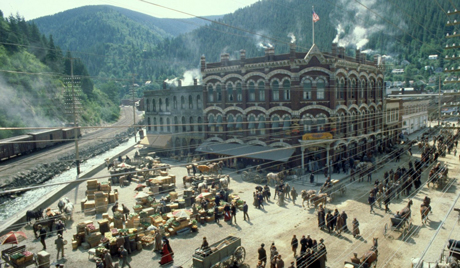
Other observations: Although he claims that politics wasn't his primary motivation for filming Heaven's Gate, Cimino's film is loaded with references to class and ethnic injustice. The Association's thugs brutally beat a poor farmer as if they were Nazis harassing Jews. As a writer Cimino is no George Lucas -- his dialogue is very good, unforced and natural. He nevertheless betrays his bias with occasional 'author's message' howlers. The Army captain is a font of wisdom: "You can't force salvation on people Jim, it doesn't work." In the first charge against the invaders, Ella shouts from horseback: "For America!" Despite her small size and vulnerable appearance actress Isabelle Huppert is ready for anything, whether it be full-frontal nudity or hard horse riding under hazardous conditions. As Heaven's Gate is pre-CGI, the daring exhibited in the mass action scenes is exciting in itself. Schematic visual themes connect several of the film's set pieces. Cimino uses "The Blue Danube" for the mass dance in Harvard Yard, with dozens of waltzing couples spinning in a giant circular pattern. Later on, the roller rink sequence sets more circular motion to music. The final battle seems a parody of both earlier events, with Ella leading a horse charge around the barricaded Association mercenaries, like Indians racing around the settlers' wagon train in Red River. In the aftermath of the siege, composer Mansfield's mandolin picks out "The Blue Danube" over a shot of the corpse-strewn battlefield. Of the three "circular" events only the roller-skating seems natural. The waltz is an attractive but artificial piece of idealized choreography, and the battle seems rather ... exaggerated. The smoke, dust, shooting, screaming and chaos makes its point after six or seven minutes but continues for an eternity. The overkill causes us to disengage. The situation is not unlike Jack Buchanan in Vincente Minnelli's The Band Wagon. A dance rehearsal is overwhelmed by unnecessary smoke, flashing lights, explosions and moving scenery. Buchanan regards the theatrical chaos he has wrought and says, "It's all a bit too much, isn't it?" The stylized choreography of the Harvard waltz suggests a nostalgic dream, the same way that Averill's retirement-age "exile" to a millionaire's yacht in the epilogue seems slightly displaced from reality. Averill's little cigarette-lighting ritual with his listless trophy wife is downright spooky, what with their lumpy old-age makeup. We almost expect the couple to suddenly notice that, in the opposite corner of the room, stands a mysterious black monolith! Either that, or the very Nino Rota- like swell of music makes us think that Averill will see a passing steamship heading for Ellis Island, with little Vito Corleone among its cargo of unwashed immigrants. Fascinating to look at but sagging with self-importance, Heaven's Gate is an underdeveloped idea drowned in lavish visual detail. We search in vain for deeper significance. 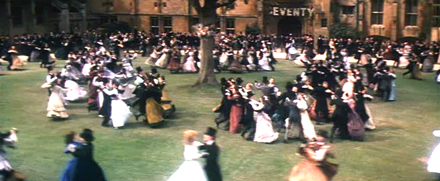
Criterion's two-disc Blu-ray of Michael Cimino's Heaven's Gate will please most fans of this unique epic. It inadvertently changed the direction of American moviemaking -- few directors would again be allowed to run free without budgetary restraints and committee oversight. The release represents a major production expenditure for Criterion. The original negative had been cut down to yield the film's short 1981 "desperation" release, which nobody liked. But as color separations had been made for the long version, Criterion went to the effort to digitally scan, scrub and recombine them. The new work was only done digitally, so this is not a film restoration job. The opportunity was there to compare the long and short versions, but the connoisseur label has a policy of releasing 'director's approved' discs. Michael Cimino has taken the liberty to change the film substantially. Although an extra on the disc is called a 'Restoration Demonstration', the key word should be revision. It's not a George Lucas- style obliteration of the original version, as only a handful of shots have been slightly altered. But the entire intermission has been removed, in an annoyingly slapdash fashion that ruins one of Cimino's most beautiful scenes. In the 1980 cut the drunken Billy Irvine sits on his horse quoting poetry, and is enveloped by a cloud of steam from the railroad engine. When it blows away, he has vanished. It's a perfect accidental magic trick, the kind of unrepeatable gem of a shot directors pray for. The scene fades as the smoke rises and the word "Intermission" comes up. This elegant transition evokes the heady days of the Road Show epic. 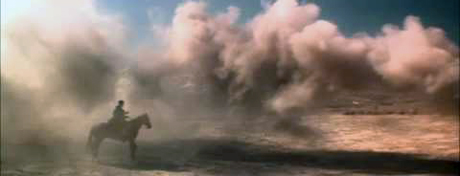
Cimino now chops off the smoke early, before we can appreciate Billy's disappearing act. The image jumps forward to the next morning, with the unlucky Cully discovered sleeping in the open by Canton's trigger-happy horde. This shot is trimmed as well. The film's best transition is now a ragged jump cut. For reference, the uncut take can be seen in the disc's extras. Cimino's second major decision is more complicated. Heaven's Gate was filmed by Vilmos Zsigmond, an artistic cameraman with visual tastes that sometimes ran counter to commercial considerations. The strongest example is perhaps Brian De Palma's Obsession, which Zsigmond shot through heavy filters. By the time the film had been duplicated for release prints, its images had degraded to a greenish grainy smear. Zsigmond originally timed Heaven's Gate to desaturate some hues, as if to eliminate the 'pretty postcard' appearance of the natural locations. The cameraman also approved MGM's earlier transfers of the film, as shown in 1080i on their MGM cable channel, where the brown-on-gold-on-brown color scheme was retained. Whatever the politics might be, Vilmos Zsigmond has not participated in the new disc. Michael Cimino has decided to ignore the original color and time the images for maximum beauty. This is a sticky problem. Before, the monochromatic color numbed the eye's rods and cones into a perceptual stupor. Watching the film is now a far more pleasant experience. Michael Cimino also supervised a re-mix of the film's soundtrack. At 2012's The Reel Thing AMIA symposium, Lee Kline of Criterion reported that the director had admitted that his inexperience at the original session was responsible for a soundtrack in which background noise frequently overwhelmed the foreground dialogue. James Averill's talks with Richard Masur's Cully at the train station and in downtown Casper were largely indecipherable, especially with Masur slurring some of his words with an Irish accent. The balance is still tight but most voices now cut through. Viewers accustomed to the drubbing given Michael Cimino and his producer Joanne Carelli in Steven Bach's book Final Cut will find that Criterion's extras stick closely to the Cimino version of events. In a long-form interview piece, the director talks in fond terms about the freedom he had to create a world from the ground up. Cimino shows the abridged intermission proudly and without explanation. There is no discussion of the revised color and little mention of Vilmos Zsigmond beyond his presence in a couple of still photos. Ms. Carelli explains how she pulled the film's music together. 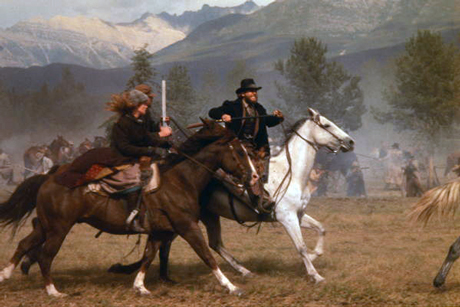
In his interview, Kris Kristofferson says that he took the film because he liked the way its politics commented on the direction of the country in the late 1970s: money is considered more important than people. David Mansfield discusses his music career and how Carelli spotted him playing with Bob Dylan. His fellow musician T-Bone Burnett is seen performing in the roller skating scene. Second assistant director Michael Stevenson doesn't talk about Cimino in a personal way, but compares him to the tough, difficult to please directors he helped make epics with a decade before -- David Lean, Anthony Mann, Richard Brooks, Stanley Kubrick. Stevenson does say that Cimino has an artist's eye like Kubrick & Mann. A Teaser Trailer and a TV spot are included. The teaser avoids moving images from the film but the faded TV spot makes all the shots look brown. For comparison, this original trailer gives a close indication of the 1980 release's original color values. The insert booklet contains an American Cinematographer interview with director Cimino, not Director of Photography Zgismond. Giulia D'Agnolo Vallan's essay lauds Cimino's film with odd comparisons (it's better than Soldier Blue?) and a positive view of the director's emulation of Visconti's style in The Leopard. She takes the European critical viewpoint, missing completely the fact that American critics were appalled not by the film's "unconventional dramatic structure" but by its lack of focus and its digressions and repetitions, along with the frequently unintelligible dialogue and reels of scenes obscured by clouds of dust. Criterion's attractive new disc makes Cimino's controversial epic more accessible than ever.
On a scale of Excellent, Good, Fair, and Poor, Reader Responses: What Savant correspondents had to say about Heaven's Gate as reviewed here. December 8 From Canadian correspondent Robert Richardson:Hi Glenn, It had been a number of years since I last watched Heaven's Gate and so while watching the Criterion Blu Ray I was instantly captivated by the scenes set in Casper, Wyoming as I realized this was a town I had visited only recently, at the very end of September. Family had relocated to Lethbridge, Alberta and I was driving to visit them; I opted to break up the journey (essentially a 14 or 15 hour uninterrupted drive) with a couple of overnight stays to allow myself easier driving days and more opportunity to explore areas I had not visited. After an initial overnight in eastern Washington State I crossed into Idaho, heading towards an overnight in the town of Hot Springs, Montana. Traveling through Idaho on I-90 I spotted signs advertising "Historic Wallace" ahead, and made a snap decision to detour for a visit. Wallace had been a big silver mining town, and this was the spot where Michael Cimino & company built their set for Casper. I did not realize it at the time of my visit, only later while looking at the disc. The historic buildings are well preserved, and the town sports both a bordello museum as well as a brewery that yields a fine Idaho Select Lager. I spent an hour wandering around, enjoying fine afternoon weather before resuming my journey. The town as it is now does not exactly resemble what you see in Heaven's Gate, as the production crew built a variety of building facades but the most significant difference is the existence of I-90. As I understand it when the interstate was being planned it initially was to run through the center of town, and blocks of historic buildings would have been razed to make way for this. The citizenry fought to preserve their town's history, and after a lengthy battle won. The rail station was relocated to the opposite side of town, and an overpass constructed at the start of the 1990s to accommodate the Interstate. In the screen capture of Casper (well, Wallace) in your review the overpass would run where the train tracks are. Lana Turner was born in Wallace, and in the mid-1990s the movie Dante's Peak was also filmed there. Following my overnight in Hot Springs, MT I drove through Kalispell and through the perimeter of Glacier National Park, exiting at the town of Browning (part of the Blackfoot Reservation). Heaven's Gate filmed in this area as well, with the town of Sweetwater built inside the Park and various interiors (roller skating, I believe) shot in Kalispell. The are is one of astonishing beauty. From Browning it was a short trip to the border with Alberta - to Cardston (birthplace of Fay Wray) and on to Lethbridge. I was likewise captivated by the scenery around Lethbridge, as that was the primary location for Days of Heaven. That enormous scenic railway bridge runs right through the middle of town. -- Merry Christmas and all the best, Rob December 9 From correspondent Kenneth Von Gunden:Boy, I hated that movie when it came out. Later, friends and I debated the "un-American" thesis it presented. Shit, the ranchers and the bankers WERE probably all corrupt and the myths of the west are phony. Still, the myth of the West, was still the main myth of this country for many years. A filmmaker has a right to make any film he or she wishes, but it's hubris to make a $40 million film that trashes so much of the mythology of the old west and then think it's going to be popular and make money. I later told my classes when we spoke about "genre expectations," that audiences (well, the two or three people in the theater) cheered when the cavalry rode to the rescue........................wait for it!.................................. of the good gu........the killers!!!! "Wait, they saved the BAD GUYS?!" The cherry on top: the woman, her menfolk dead, who puts the revolver in her mouth and blows out her brains! Good night and have a safe drive home -- Where's Randolph Scott when we need him! -- Ken Von Gunden December 10 From correspondent Drew Fitzpatrick:
Though I'm a huge fan of Cimino and the film, all your criticisms are well taken and many are inarguable. I'm actually glad to hear someone else mention what a crippling change the removal of the intermission was -- since this version was prepared for home viewing, could Cimino really have been concerned about the running time? But there was another, far more subtle change during the prologue that left me scratching my head. The prologue's final shot had always been a beautiful pan away from the girl's face in the window, followed by the wonderfully abrupt cut to the train conductor about to wake Averill up 20 years later, while Mansfield's music swells in the background. I always found this a transition worthy of David Lean (or Anne V. Coates) but for this version, Cimino reversed the shot on the Harvard girl so the camera now pans toward her, completely changing the meaning of the shot. I still love the film - and it played beautifully at the New York Film Festival, where I was able to see Cimino and Kristofferson finally get the applause long denied them - but I found the changes very puzzling. -- Best, Drew Fitzpatrick December 13 From correspondent (and fellow western fanatic) Gregory Nicoll:Hey, Glenn, Loved your piece on Heaven's Gate. Way back in 1979 when I was working as an extra on the set of Walter Hill's The Long Riders, I had many long conversations with stuntmen who had fled the set of Cimino's fiasco, all of them with wild tales to tell about its director improvising sequences on a whim and causing total havoc on the set. One guy told me about frantically pulling children out of the path of a wagon which wasn't even supposed to have been used in that particular sequence, but which Cimino suddenly (while the cameras were rolling) ordered to be driven rapidly up the street, putting the extras in harm's way. Our biggest problem on The Long Riders was getting usable props. Heaven's Gate was endlessly tying up the lion's share of period firearms, and Cimino made it worse by (once again, unexpectedly) ordering his crowds of extras to smash their irreplaceable antique rifles against the ground and the ice. This created a shortage which forced The Long Riders' prop department to stock up with what one stunt player charitably described as "the shit." I experienced the issue firsthand when I was involved in a sequence during The Long Riders' Northfield raid, and the broken-down Winchester Model 92 which I was firing (normally a very slick, reliable gun) got jammed up after discharging just two blank cartridges. Eventually when I struggled hard with it and forced its lever down, the hot empty brass shell was ejected down my collar, causing burns on my chest and stomach. (The burns looked like green caterpillars embedded under my skin.) When the Walter Matthau movie Hopscotch began shooting shortly thereafter, actor Sam Waterston reported for work on it directly from Cimino's set. He looked so haggard after being put through the Heaven's Gate ordeal that Hopscotch screenwriter Brian Garfield was obliged to write some additional dialogue for his movie to explain away Waterston's visible weariness as the effects of jet leg. I was so disgusted by all of this that I didn't get around to actually seeing Heaven's Gate until nearly 25 years later, when I found it to be an even bigger, more ungainly mess than I'd long suspected it was. Keep up the great work! -- Gregory Nicoll
Reviews on the Savant main site have additional credits information and are often updated and annotated with reader input and graphics. Also, don't forget the 2011 Savant Wish List. T'was Ever Thus.
Review Staff | About DVD Talk | Newsletter Subscribe | Join DVD Talk Forum |
| ||||||||||||||||||